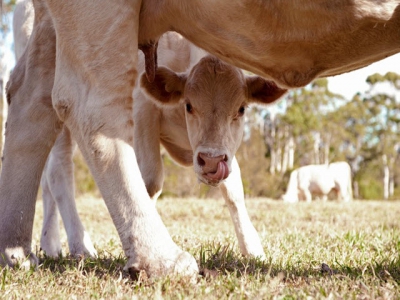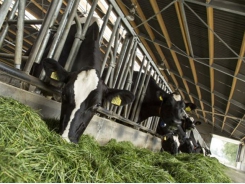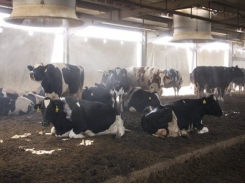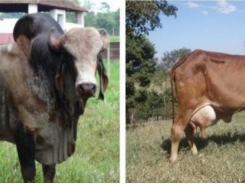Cows high selenium diets may boost protein transfer to calves

Supplementing pregnant cow diets with levels of selenium could improve the passive transfer of immunoglobulin to calves, say researchers.
A team of researchers from Oregon State University explored the use of selenium (Se) supplementation in beef cows to improve the nutritional start and passive transfer of ovalbumin (OVA), as a surrogate marker for immunoglobulin (IgG), to calves.
The group members published their work in the Journal of Trace Elements in Medicine and Biology.
“The objective of this study was to determine if feeding Se-replete beef cows Se-enriched alfalfa (Medicago sativa) hay during the last trimester of gestation delays turnover and replacement of fetal intestinal epithelial cells in their calves, thus extending the period of time during which large proteins can be transferred from intestinal lumen to neonatal blood,” the researchers said.
Oral ovalbumin was administered after birth to help track when the gut closed because if the process did prolong passive transfer OVA levels in calves would be higher at multiple times compared to control calves, they added.
During the feeding trials, researchers found that calves receiving an oral dose of OVA at 12 hours post-birth had higher levels of OVA in their blood serum for the first 48 hours of life when born to cows on the High-Se diet compared to calves from cows on the control diet.
“This suggests that supranutritional Se supplementation of dams can improve passive transfer by increasing the amount of protein transferred,” they said. “It is possible that neonatal small intestinal development can be affected by maternal Se nutrition in cattle during the third trimester of gestation, thereby altering passive transfer capacity in newborn calves.”
Feeding the dam Se-bio-fortified alfalfa hay for the final 8 weeks of pregnancy could boost the Se status of the neonatal calf, they said.
“In addition, feeding Se-fortified alfalfa hay to the pregnant beef cow increases IgG1 concentrations in colostrum,” the researchers said. “Based on these results from OVA administration, we suggest that early feeding will also increase IgG1 concentrations in calves from High-Se dams receiving similar volumes/concentrations of IgG1 colostrum compared to Control calves.”
Why ovalbumin transfer and high-selenium alfalfa?
Immunoglobulins (Ig) transfer to a newborn calf through the colostrum in a passive transfer of Ig through intestinal epithelium, the researchers said. There is no transfer of Ig in utero.
Maternal Ig helps protect neonates from diarrhea, enteric disease and respiratory disease after birth and calves that fail to have the passive transfer are at risk of infection, sepsis and death, they said.
“Calves that fail to suckle adequately possess low concentrations of Ig in their serum,” they said. “Therefore, intestinal absorption of a sufficient amount of Ig is a key factor in neonatal health and survival.”
The predominant IgG subclass in colostrum is immunoglobulin IgG1, the researchers said.
At birth, calves have a digestive tract that aids absorption of colostral proteins as the level of proteolytic activity is low in both the small intestine and abomasum and there are trypsin inhibitors in colostrum.
However, three processes have to take place for the calf to successfully absorb the needed IgG1 – “pinocytosis of large proteins, transcellular transfer of proteins across the enterocyte, and exocytosis of proteins into the lymphatic system,” they said.
That system allows for calves to receive maternal IgG1 through passive transfer.
“The period during which the intestine is permeable to IgG1 varies in calves, but is highest immediately after birth, declines after 6 h, and drops to relatively low levels by 24 h, signaling gut closure to passive transport,” they said. “Peak serum IgG1 concentrations are normally reached 32 h postpartum.”
When absorption stops, the concentration of passively transferred IgG1 start to fall, they added.
Previous research found that supplementing dairy cows with a Se-yeast during the dry period or adding Na-selenite to colostrum boosted the IgG status of the calves, the researchers said. However, the mechanism involved in improving passive transfer remains unknown.
It has been postulated that selenium may act directly on intestinal epithelial cells, or that supranutritional amounts of Se slow the process that replaces cells capable of passive transfer with more mature cells that are incapable of it, they said.
To test a hypothesis that passive transfer would be enhanced for calves from dams receiving Se-bio-fortified hay when compared to calves from control group dams given the USDA approved limit of Na-selenite, calves received 25g oral ovalbumin at 12, 24 or 36 hours after birth, they said.
Serum OVA levels were measured to estimate when the gut closed.
“We chose OVA with 44,300 Da molecular weight (MW) as a surrogate protein for IgG (the bovine IgG molecule is approximately 150,000 Da MW) because human albumin with 68,000 Da MW and human IgG with 163,000 Da MW have been previously shown to be absorbed equally in relation to total dose in calves,” they said. “If passive transfer was prolonged by enhanced Se intake in dams, we expected OVA concentrations in serum of newborn calves to be higher at all dosing time points compared to Control calves.”
Feeding trial details
In the study, 45 pregnant beef cows were given one of three diets for a period starting at about 7 months of pregnancy, the researchers said.
The diets included a control, with non-selenium fortified alfalfa hay at 5.3mg Se daily with a mineral supplement containing inorganic selenium at 3mg daily; a medium diet (Med-Se) with Se-bio-fortified alfalfa at 27.6mg Se daily and a mineral supplement without added selenium; or a high diet (High-Se) with 57.5mg Se in the hay and a mineral supplement not containing selenium, they said.
Diets included hay, about 70% was alfalfa and 30% grass hay.
Calves remained with their dams for 48h post calving, the researchers said. Calves received an oral dose of OVA at 12, 24 or 36 hours post birth and body weights were recorded at 2h post-birth and after 48h.
Equal numbers of calves from dams on each diet were selected to have an oral dose of OVA at 12, 24 or 36h after birth, they said. Colostrum samples were collected prior to first nursing and blood samples were taken from calves at 2, 12, 24, 36 and 48h after birth.
Results
Colostrum samples from cows showed increasing amounts of Se as more of the nutrient was added to their diet, the researchers said. Concentrations were 119, 504 and 1,336ng/mL for cows on the control, Med-Se or High-Se diets respectively.
In the calves, Se levels also increased linearly according to dam diet, they said. However, levels for all calves decreased during the first 48 hours.
Similarly, IgG1 concentration of colostrum increased linearly, they said. Serum IgG1 concentrations in calves were not detectable prior to colostrum intake but were present by 12h post birth for all calves.
IgG1 concentrations tended to increase from 12 to 24h, were similar at 36h and had started to decline by 48h, they said. No effect of Se was noted.
However, if OVA is given orally to newborn calves in the first 12h after birth, there was a larger passive transfer for calves from dams receiving the High-Se diet, they said.
“Our results, using OVA as a model for passive transfer, suggest that if calves do not receive adequate colostrum to reach maximum pinocytosis, then supranutritional Se supplementation in beef cattle may improve passive transfer in their calves, if calves receive colostrum within the first 12 h of age,” the researchers said.
Calves having the first dose of OVA at 12h had more serum OVA for the first 48h when they also were born to cows on the High-Se feed when compared to control group calves, they said.
However, when calves received the OVA at 24 or 36h all calves were found to have similar serum OVA concentrations.
“We suggest that an enhanced Se status at birth improves passive transfer at or before 12 h of age, but the beneficial effect disappears if the surrogate protein marker is administered when calves are older (24 and 36 h of age)."
However, the mechanism that allows the High-Se diet to improve colostral IgG1 remains unknown:
“Our hypothesis that passive transfer is enhanced in calves born to cows fed Se-bio-fortified alfalfa hay in the last trimester of pregnancy was confirmed if calves received colostrum within the first 12 h of age."
Source: Journal of Trace Elements in Medicine and Biology
Authors: K. D. Apperson, W. Vorachek, B. Dolan, G. Bobe, G. Pirelli, J. Hall
Related news
Tools

Phối trộn thức ăn chăn nuôi

Pha dung dịch thủy canh

Định mức cho tôm ăn

Phối trộn phân bón NPK

Xác định tỷ lệ tôm sống

Chuyển đổi đơn vị phân bón

Xác định công suất sục khí

Chuyển đổi đơn vị tôm

Tính diện tích nhà kính

Tính thể tích ao




 Transponders monitor cow activity to support lameness management
Transponders monitor cow activity to support lameness management  Genes identified that could lead to beef cattle…
Genes identified that could lead to beef cattle…